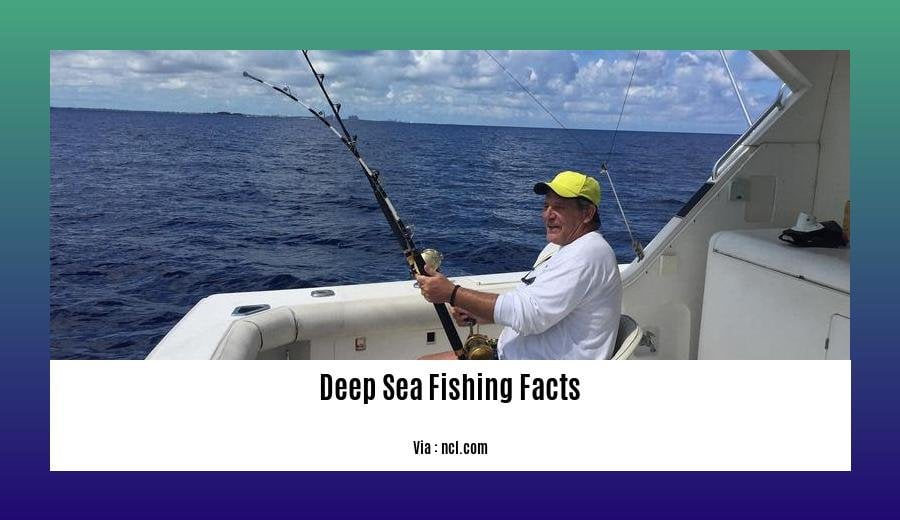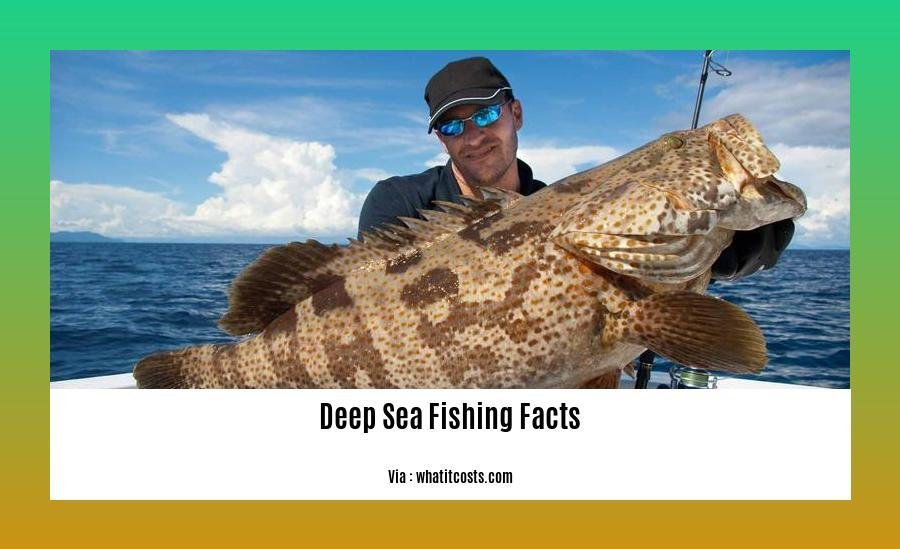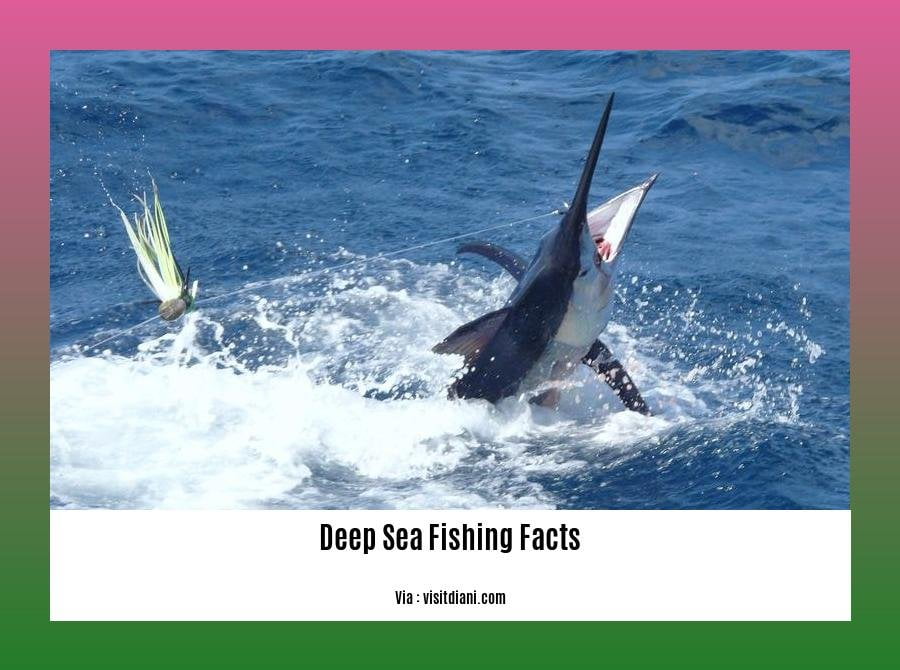Delve Into the Depths: Fascinating Deep Sea Fishing Facts and Discoveries
Embark on an awe-inspiring journey into the mysteries of the ocean as we explore the captivating world of deep sea fishing. With its vastness and depth, the deep sea holds countless wonders waiting to be discovered. Join us as we dive into a realm teeming with extraordinary marine life, remarkable fishing techniques, and enthralling facts that will leave you mesmerized. Whether you’re an avid angler or simply curious about the secrets hidden beneath the waves, prepare to be astounded by the incredible insights and discoveries brought to you by experts in the field. From peculiar fish species to the latest fishing equipment innovations, this article will take you on an unforgettable adventure into the depths. Get ready to unlock a treasure trove of knowledge and immerse yourself in the exhilaration of deep sea fishing.
Key Takeaways:
- Deep sea fishing takes place at a water level of at least 30 meters or 100 ft deep, where sunlight can’t reach.
- More than 10 million species reside in the deep sea, with only 33% of them discovered so far.
- Deep-sea fish differ from inshore fish due to varying preferences for habitats, food sources, and water temperature.
- Deep-sea fishing gear is designed to withstand the challenging conditions of the deep sea.
- Fishing conditions in deep-sea fishing are constantly changing, affecting the type of fish that can be caught.
- Depths can reach up to 2,000 feet in deep-sea fishing.
- Moon phases and weather fronts can influence the quality of catches in deep-sea fishing.
- Deep-sea fishing allows for exploration of different oceans and diverse fishing conditions worldwide.
Deep Sea Fishing Facts

Deep sea fishing is an exhilarating and challenging sport that allows anglers to explore the depths of the ocean and experience the thrill of catching elusive and extraordinary fish species. In this article, we will delve into the fascinating world of deep sea fishing facts, uncovering the mysteries that lie beneath the surface. So grab your gear and let’s dive in!
The Depths of the Deep Sea
To truly understand deep sea fishing, we must first comprehend the depths at which it takes place. Deep sea fishing typically occurs at a water level of at least 30 meters or 100 feet deep. The depth of the sea is determined by the penetration of sunlight, as marine ecosystems rely heavily on this vital energy source. As we descend into the depths, the darkness becomes more profound, and the conditions become increasingly challenging.
A Hidden World of Marine Life
Did you know that the deep sea is home to more than 10 million species? Astonishingly, we have only scratched the surface, with only around 33% of these unique creatures being discovered so far. This vast and mysterious ecosystem harbors an abundance of life, from bioluminescent organisms to bizarre and fascinating deep-sea fish species. Exploring the uncharted depths is an opportunity to witness nature’s wonders at its finest.
The Habitats of Deep-Sea Fish
Deep-sea fish species are incredibly diverse, each with its own preferred habitat and adaptations. These fish differ from their inshore counterparts, as they have evolved to thrive in the challenging conditions of the deep sea. Factors such as food sources, water temperature, and available light play crucial roles in determining the habitats of these remarkable creatures. Some species prefer the rugged seafloor, while others roam the water column in search of prey.
Gear up for the Deep
Deep-sea fishing requires sturdy and durable gear that can withstand the demanding conditions of the ocean depths. Specialized equipment, such as heavy-duty rods, reels, and lines, is necessary to handle the powerful and often colossal fish that reside in these depths. These tools must be built to withstand the immense pressure and unpredictable nature of deep-sea fishing, ensuring that anglers are well-equipped for the ultimate battle with their elusive prey.
Ever-Changing Conditions
One of the unique aspects of deep-sea fishing is the ever-changing conditions that anglers face. From shifts in water quality to fluctuations in temperature and weather patterns, these factors greatly influence the behavior and abundance of fish in the deep sea. Understanding these dynamics and adapting your fishing techniques accordingly can significantly increase your chances of a successful catch.
Secrets of the Moon and Weather
When it comes to deep sea fishing, the moon phases can have a surprising impact on the quality of your catches. As the moon waxes and wanes, it affects the feeding patterns and activity levels of deep-sea fish, presenting anglers with opportunities for an abundance of bites. Additionally, weather fronts play a significant role in deep-sea fishing. When a front is approaching, bringing cooler air, deep-sea fish tend to become more active, making it an ideal time for fishing.
Embrace the Adventure
Deep-sea fishing holds a world of exploration and adventure, allowing anglers to immerse themselves in the beauty and vastness of the oceans. Whether you cast your line in the Caribbean, explore the depths of the Pacific, or venture to the far corners of the globe, deep-sea fishing offers the opportunity to experience a variety of ecosystems, fishing conditions, and the thrill of encountering truly remarkable fish species.
In conclusion, deep sea fishing is a captivating endeavor that unravels the mysteries hidden beneath the ocean’s surface. Armed with knowledge about the depths, diverse habitats, gear requirements, and factors that impact fishing conditions, you are now equipped to embark on your own deep-sea fishing adventure. So pack your bags, prepare your gear, and get ready to uncover the awe-inspiring world of the deep sea. Happy fishing!
Here are some interesting facts about the Common snapping turtle. Did you know that they can live up to 100 years and weigh over 35 pounds? Discover more about these fascinating creatures by clicking here.
Pakistan is home to several critically endangered species. Explore the unique wildlife of Pakistan and learn about the efforts to protect them by clicking here.
Looking for some cuteness overload? Check out the cutest octopus species and be amazed by their adorable appearance. Dive into the world of these charming creatures by clicking here.
Prepare to be amazed by the fascinating world of the deep sea dragonfish. Discover its unique adaptations and uncover its secrets by clicking here.
The Curious Behavior of Deep Sea Fish
Deep sea fish possess a multitude of remarkable characteristics and behaviors that make them truly fascinating creatures. Let’s delve into the depths of the ocean and uncover some of the most intriguing facts about the curious behavior of these underwater inhabitants.
Adaptations for Survival
Deep sea fish have evolved a range of unique adaptations to survive in the challenging environment of the deep sea. One fascinating adaptation is the possession of long, slender bodies that allow them to swiftly navigate through the water, while others have flattened bodies that enable them to effortlessly glide along the ocean floor[^1^].
Furthermore, many deep sea fish boast an arsenal of sharp teeth, which are essential for catching prey in the darkness of the deep sea. These razor-like teeth provide them with the means to secure their next meal in an environment where visibility is scarce[^1^].
Another crucial adaptation found in deep sea fish is their swim bladder, an organ that helps control their buoyancy. This specialized structure allows them to adjust their position in the water column, maximizing their chances of survival[^2^].
Bioluminescent Marvels
One of the most captivating aspects of deep sea fish behavior is their ability to produce bioluminescent light. This extraordinary adaptation serves multiple purposes, from attracting prey to communicating with other fish.
The anglerfish is a well-known example of a deep sea fish with a mesmerizing bioluminescent lure. This illuminating appendage dangles in front of the fish’s mouth, attracting unsuspecting prey towards its deadly jaws[^1^]. It’s quite a spectacle to witness these glowing creatures in the depths of the ocean!
The Mysteries of the Deep Sea
The deep sea is a vast and mysterious realm, covering more than half of the Earth’s surface and serving as the largest habitat on the planet[^1^]. It is teeming with an extraordinary array of organisms, many of which exhibit bizarre and unusual behaviors that continue to baffle scientists and researchers.
Deep sea fish, with their curious behavior, add to the myriad enigmas of this fascinating underwater world. From their astonishing adaptations to their captivating bioluminescent displays, these elusive creatures hold the secrets to a world yet to be fully understood[^1^].
Key Takeaways:
- Deep sea fish possess unique adaptations such as long, slender bodies and sharp teeth to navigate and catch prey in the deep sea[^1^].
- Many deep sea fish exhibit bioluminescent behavior, using light both to attract prey and communicate with other fish[^1^].
- The deep sea is a mysterious and largely unexplored habitat, providing endless opportunities for scientific discoveries[^1^].
Sources:
– American Oceans
– Charter Fishing Destin
Essential Equipment for Deep Sea Fishing

Deep sea fishing is an exhilarating adventure that requires the right equipment to ensure a successful and enjoyable experience. Whether you’re a seasoned angler or new to the sport, having the essential gear is essential for a fruitful fishing trip. In this article, we will delve into the depths of deep sea fishing and explore the equipment that is crucial for a successful expedition.
The Sturdy Boat: A Fisher’s Best Friend
Any deep sea fishing excursion starts with the right vessel. A sturdy and reliable boat is essential to navigate the open ocean and withstand the sometimes harsh conditions. When choosing a boat, consider its size, stability, and the number of people it can accommodate comfortably. A spacious deck area and ample storage space are advantageous for tackling large fish and accommodating the necessary fishing gear.
Rods and Reels: The Tools for Success
Having the right fishing equipment is imperative for reeling in those big catches. Deep sea fishing requires robust and durable rods and reels designed to handle the power and weight of larger fish species. Look for rods with a heavy or medium-heavy action, as they provide the strength needed to haul in those deep sea monsters. Pair these rods with reels that have a high line capacity and a smooth drag system to successfully battle fish in the depths.
Fishing Line: Don’t Underestimate Its Importance
Choosing the right fishing line can make a significant difference in deep sea fishing. Opt for a strong, abrasion-resistant line with a high pound test rating to handle the powerful pulls of deep sea fish. Fluorocarbon and braided lines are popular choices among deep sea anglers due to their strength and low visibility underwater. Remember to inspect and replace your fishing line regularly to avoid any unexpected breaks and missed opportunities.
Hooks and Lures: Attracting the Prize Catches
Hooks and lures are essential tools for attracting and hooking fish during deep sea fishing. Make sure to have a variety of sizes and styles to accommodate different fish species and conditions. Circle hooks are widely used in deep sea fishing as they often result in a higher rate of catch and release success. Additionally, brightly colored lures with feathers or skirts are effective in enticing fish to strike, mimicking the natural prey they feed on.
Spotting the Perfect Spot: Research Is Key
Research and finding the right fishing spot are vital to the success of any deep sea fishing expedition. Use resources such as charts, maps, and online fishing reports to locate areas known for productive fishing grounds. Factors such as water temperature, underwater structures, and current patterns can greatly influence where fish congregate. Take advantage of local knowledge and consider hiring a guide or joining a fishing charter to increase your chances of success.
Safety and Comfort: Protecting Yourself on the Open Ocean
Deep sea fishing can expose you to the elements, so it’s important to have the necessary attire and protection. Pack sunscreen with a high SPF rating, protective clothing, hats, and sunglasses to shield yourself from the sun’s harmful rays. Dress in layers to adjust to changing weather conditions and bring along rain gear to stay dry in case of unexpected showers. Also, invest in non-slip footwear for stability on the boat and consider wearing a life jacket for additional safety.
Key Takeaways:
- A sturdy and reliable boat is necessary for a successful deep sea fishing trip.
- Deep sea fishing requires the right equipment such as rods and reels.
- The fishing line used in deep sea fishing can make a massive difference.
- Hooks and lures are crucial in attracting and hooking fish during deep sea fishing.
- Research and finding the right spot is important in deep sea fishing techniques.
- Deep sea fishing requires a big boat to handle the open ocean, large fish, and massive amounts of gear.
- It is important to have the necessary attire and protection from the weather and sun during deep sea fishing.
Sources:
– “WHAT’S DEEP SEA FISHING?” – sea fishing adventurer. source
– “Deep Sea Fishing: boats, fish species & techniques” – Tom’s Catch. source
Challenges and Tips for Deep Sea Fishing
Challenges and Dangers of Fishing in the Deep Sea
Fishing in the deep sea presents a unique set of challenges and dangers that fishermen need to consider. From strong currents and extreme weather conditions to unpredictable marine life and the risk of becoming lost or stranded at sea, there are various factors that make deep sea fishing a challenging endeavor. Additionally, health risks such as dehydration and hypothermia, as well as issues like overfishing, bycatch, habitat destruction, illegal fishing practices, climate change, technological limitations, and insufficient conservation efforts further contribute to the risks and threats associated with deep-sea fishing.
Strong currents and undercurrents
The deep sea is known for its strong and unpredictable currents, which can make fishing difficult and dangerous. These currents can make it challenging to keep your fishing line steady, potentially leading to lost catches or equipment damage[^1].
Extreme weather conditions
Fishermen face harsh weather conditions such as storms, high winds, and rough seas while fishing in the deep sea. These conditions can make it difficult to navigate, put strain on your boat, and pose risks to your safety[^1].
Unpredictable marine life
The deep sea is home to various marine creatures, including sharks, jellyfish, and other large predators that can pose threats to fishermen. It’s essential to be aware of the potential presence of these creatures and take precautions to ensure your safety[^1][^2].
Possibility of becoming lost or stranded at sea
Due to the vastness and remote nature of the deep sea, fishermen are at risk of getting lost or stranded without proper navigation systems or communication devices. It’s crucial to have the necessary equipment and knowledge to navigate the waters and communicate with the shore[^1].
Dehydration and hypothermia
Prolonged exposure to cold water can lead to dehydration and hypothermia, which are serious health risks for fishermen. It’s essential to stay hydrated and dress appropriately to protect yourself from these risks[^1].
Overfishing
Overfishing is one of the greatest problems associated with deep-sea fishing. It depletes fish populations and disrupts marine ecosystems. To mitigate this challenge, it’s crucial to practice sustainable fishing methods, adhere to catch limits, and support conservation efforts[^2].
Bycatch
Bycatch refers to the accidental capture of non-target species during deep-sea fishing. It occurs frequently and contributes to the decline of various marine species. Fishermen can minimize bycatch by using selective fishing techniques and proper handling of caught species[^2].
Habitat destruction
Deep-sea fishing can cause habitat destruction, particularly through bottom trawling, which damages the seafloor and disrupts fragile deep-sea ecosystems. Efforts should be made to minimize the impact on the environment and explore alternative fishing methods[^2].
Illegal, unreported, and unregulated fishing
Deep-sea fishing is vulnerable to illegal, unreported, and unregulated practices, which further exacerbate the depletion of fish populations. Strict monitoring and enforcement of fishing regulations are necessary to address this issue[^2].
Climate change
Climate change impacts the deep sea through rising seawater temperatures, ocean acidification, and changes in ocean currents, which can disrupt marine ecosystems and affect fish populations. Understanding and mitigating the effects of climate change are crucial for the sustainability of deep-sea fishing[^2].
Technological limitations
Fishing in the deep sea is challenging due to technological limitations. Advanced equipment and vessels are required to withstand the harsh conditions and depths of the deep sea. Investing in high-quality gear and staying informed about advancements in fishing technology can enhance your fishing experience[^2].
Insufficient conservation efforts
Despite the challenges and dangers, conservation efforts in deep-sea fishing are often insufficient, leading to ongoing threats to marine biodiversity and sustainable fishing practices. Supporting organizations and initiatives that promote responsible fishing and conservation can help address this issue[^2].
Deep sea fishing is not without its challenges and risks, but with proper preparation, knowledge, and adherence to sustainable fishing practices, it can be a rewarding and exciting experience. By understanding and addressing the challenges associated with deep-sea fishing, we can ensure the preservation of marine ecosystems and the long-term sustainability of this activity.
Key Takeaways:
- Fishing in the deep sea poses challenges such as strong currents, extreme weather conditions, and unpredictable marine life.
- Risks of becoming lost or stranded at sea, dehydration, and hypothermia should be considered.
- Overfishing, bycatch, habitat destruction, illegal fishing practices, climate change, technological limitations, and insufficient conservation efforts are additional challenges.
- Sustainable fishing practices, selective fishing techniques, and proper handling of caught species can help mitigate challenges.
- Supporting organizations and initiatives that promote responsible fishing and conservation is crucial.
Sources:
FAQ
Q1: What is deep sea fishing?
A1: Deep sea fishing is a type of fishing that takes place at a water level of at least 30 meters or 100 ft deep. It involves exploring the depths of the ocean to catch fish species that inhabit these deeper waters.
Q2: How many species live in the deep sea?
A2: The deep sea is home to more than 10 million species, although only around 33% of them have been discovered so far. This vast and largely unexplored habitat offers a diverse range of organisms to be discovered.
Q3: How does deep sea fishing differ from inshore fishing?
A3: Deep sea fishing differs from inshore fishing in several ways. The habitats preferred by different fish species vary based on factors such as food sources and water temperature. Deep sea fish are generally larger in size, and therefore, specialized techniques and equipment are required to catch them.
Q4: What are the dangers of fishing in the deep sea?
A4: Fishing in the deep sea poses several challenges and dangers. These include strong and unpredictable currents, extreme weather conditions, the presence of marine predators, the possibility of becoming lost or stranded at sea, and health risks such as dehydration and hypothermia. Additionally, overfishing, bycatch, habitat destruction, and illegal fishing practices further contribute to the risks and threats associated with deep-sea fishing.
Q5: How does climate change affect deep sea fishing?
A5: Climate change has significant impacts on the deep sea and deep sea fishing. Rising seawater temperatures, ocean acidification, and changes in ocean currents can disrupt marine ecosystems and affect fish populations. These changes can alter the distribution and behavior of deep-sea fish, posing challenges for fishermen and impacting the sustainability of deep-sea fishing practices.















